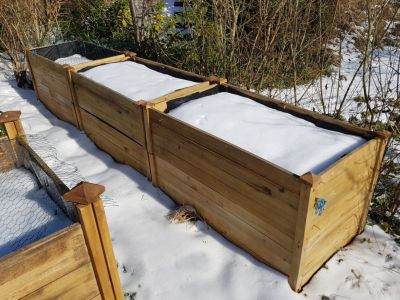How to Prepare Vegetable Garden Beds for Winter
The first order of business when getting the garden ready for winter is sanitation. Remove any spent crop detritus and compost. Break everything down into smaller pieces and mix in shredded leaves to create a balance of nitrogen to speed up decomposition. Do not incorporate any plants that show signs of disease or insect problems, as they will infiltrate the compost pile and cause future problems. Dispose of these in the trash or burn them if allowed to do so in your region. Also, thoroughly weed the garden but don’t compost the perennial weeds. They will likely reseed themselves and become the bane of your existence if you use the compost in the garden the successive season. Other items on the list of winter prep for vegetable gardens are to remove any unused stakes, ties, and trellises and allow to air dry before storing. This is also a great time to clean and oil gardening tools.
More on Preparing a Vegetable Garden for Winter
At this time in your veggie garden winter preparation, it’s time to think of your soil. You may wish to have the soil tested to see if and what type of amendment would be most beneficial. Depending upon the test results, soil improvement may be needed with the addition of lime, organic matter, or fertilizer. Lime is added to the soil to make it more neutral and is added every other year or third year for heavy soils. For every 100 feet (31 m.), mix in 4 pounds (2 kg.) of lime for sandy soil, 6 pounds (3 kg.) for loamy soil, or 8 pounds (4 kg.) for clay soils and blend into the top 8 to 10 inches (20-25 cm.). Organic matter, such as compost, can be added any time of the year; however, in the fall straw is often added to prevent weeds and retain moisture. Additionally, this is a good time to till in some fresh manure. Fertilizing in the fall is often an exercise in futility since it will likely wash down through the soil and into the groundwater. A better thing to do is to plant a cover crop that will protect the soil and aid in nutrient retention. There are many cover crops or green manure, such as crimson clover, fava beans, field peas, vetch, and legumes. Legumes are great since they add nitrogen to the soil and enrich it when the soil is turned in the spring. Some planting may also occur at this time when getting the garden ready for winter. Garlic, for instance, is always best when planted in the fall. There are other cool crop plants suitable for this season. Lastly, before putting the garden to bed for the winter, take some notes. It’s a good idea to keep a record of what crops did well or not. Photos or a sketch of the garden will also keep it fresh in your mind and remind you of successes or defeats. Also write down the soil amendments you have made. Proper sanitation, soil amendment, and the addition of organic matter with the use of green manures will ensure a bumper crop in the following year.
